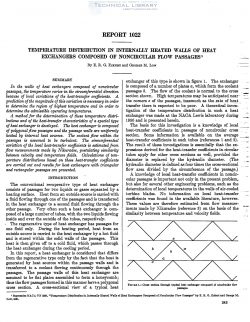naca-report-1022

- Version
- 165 Downloads
- 1.47 MB File Size
- 1 File Count
- September 1, 2016 Create Date
- September 1, 2016 Last Updated
National Advisory Committee for Aeronautics, Report - Temperature Distribution in Internally Heated Walls of Heat Exchangers Composed of Noncircular Flow Passages

In the walls of heat exchangers composed of noncircular
passages, the temperature caries in the circumferential direction
because of local rariations of the heat-transfer coqficients. A
prediction of the magnitude of this initiation is necessary in order
to determine the region of highest temperature and in order to
determine the admissible operating temperatures.
A method for the determination of these temperature distri—
butions and of the heat—transfer characteristics of a special type
of heat exchanger is developed. The heat exchanger is composed
of polygonal )1 our passages and the passage walls are uniformly
heated by internal heat sources. The coolant flow within the
passages is assumed to be turbulent. The circumferential
variation of the local heat—transfer coqfh‘cients is estimated from
flow measurements made by Nihuradse, postulating similarity
between velocity and temperature fields. Calculations of tem—
perature distributions based on these heat-transfer coeficients
are carried out and results for heat exchangers with triangular
and rectangular passages are presented.
The conventional recuperative type of heat exchanger
consists of passages for two liquids or gases separated by a
heating surface. Heat from an outside source is carried with
a fluid flowing through one of the passages and is transferred
in the heat exchanger to a second fluid flowing through the
other passage. Very often such a heat exchanger is com-
posed of a large number of tubes, with the two liquids flowing
inside and over the outside of the tubes, respectively.
The regenerative type of heat exchanger has passages for
one fluid only. During the heating period, heat from an
outside source is carried to the heat exchanger by a hot fluid
and is stored within the solid walls of the passages. This
heat is then given off to a cold fluid, which passes through
the heat exchanger during the cooling period.
| File | Action |
|---|---|
| naca-report-1022 Temperature Distribution in Internally Heated Walls of Heat Exchangers Composed of Noncircular Flow Passages.pdf | Download |

Comment On This Post